Influence of High-Pressure Die Casting Process Parameters on the Compound Strength of Hybrid Components with Undercut Sheet Metal
Abstract
:1. Introduction
2. State of the Art
3. Methods and Processes
3.1. Production of Steel Sheet Inserts for HPDC
3.2. High-Pressure Die Casting of the Hybrid Part
3.3. Casting of the Hybrid Component and Preparation of the Tensile Testing Sample
3.4. Static and Dynamic Testing of the Demonstrator Part
4. Results and Discussion
5. Summary and Conclusions
- (1)
- Complete filling of the channel structure is critical to the strength of the compound:
- ○
- Increasing the melt and die temperature reduces the risk of cold flow and increases the ability of the melt to fill the undercut channels, resulting in a higher strength during testing.
- ○
- Significantly lower gate velocities during the mold filling phase and premature changeover points result in poorer channel filling and reduced compound strength.
- ○
- Too high gate velocities also reduce the compound strength via increasing the level of porosity observed in the channels.
- (2)
- The evaluation of upstream and downstream processes such as insert preheating, post-casting water quenching and an additional T6 heat treatment did not significantly affect the test performance, thus reinforcing the main conclusion (1).
Author Contributions
Funding
Data Availability Statement
Acknowledgments
Conflicts of Interest
References
- Meschut, G.; Merklein, M.; Brosius, A.; Drummer, D.; Fratini, L.; Füssel, U.; Gude, M.; Homberg, W.; Martins, P.; Bobbert, M.; et al. Review on mechanical joining by plastic deformation. J. Adv. Join. Process. 2022, 5, 100113. [Google Scholar] [CrossRef]
- Pasligh, N. Hybride Formschlüssige Strukturverbindungen in Leichtbaustrukturen aus Stahlblech und Aluminiumdruckguss. Ph.D. Thesis, Gießerei-Institut, RWTH Aachen University, Aachen, Germany, 2011; p. 224. [Google Scholar]
- Mori, K.; Bay, N.; Fratini, L.; Micari, F.; Tekkaya, A.E. Joining by plastic deformation. CIRP Ann. Manuf. Technol. 2013, 62, 673–694. [Google Scholar] [CrossRef]
- Cai, W.; Daehn, G.; Vivek, A.; Li, J.; Khan, H.; Mishra, R.S.; Komarasamy, M. A State-of-the-Art Review on Solid-State Metal Joining. J. Manuf. Sci. Eng. 2019, 141, 031012. [Google Scholar] [CrossRef]
- Mishra, R.S.; Ma, Z.Y. Friction stir welding and processing. Mater. Sci. Eng. R Rep. 2005, 50, 1–78. [Google Scholar] [CrossRef]
- Li, L.; Nagai, K.; Yin, F. Progress in cold roll bonding of metals. Sci. Technol. Adv. Mater. 2008, 9, 23001. [Google Scholar] [CrossRef]
- Milner, D.R.; Rowe, G.W. Fundamentals of Solid-Phase Welding. Metall. Rev. 1962, 7, 433–480. [Google Scholar] [CrossRef]
- Salamati, M.; Soltanpour, M.; Fazli, A.; Zajkani, A. Processing and tooling considerations in joining by forming technologies; part A—Mechanical joining. Int. J. Adv. Manuf. Technol. 2019, 101, 261–315. [Google Scholar] [CrossRef]
- Pickin, C.G.; Young, K.; Tuersley, I. Joining of lightweight sandwich sheets to aluminium using self-pierce riveting. Mater. Des. 2007, 28, 2361–2365. [Google Scholar] [CrossRef]
- He, X. Clinching for sheet materials. Sci. Technol. Adv. Mater. 2017, 18, 381–405. [Google Scholar] [CrossRef]
- Mori, K.; Abe, Y. A review on mechanical joining of aluminium and high strength steel sheets by plastic deformation. Int. J. Lightweight Mater. Manuf. 2018, 1, 1–11. [Google Scholar] [CrossRef]
- Bührig-Polaczek, A.; Röth, T.; Baumeister, E.; Nowack, N.; Süßmann, T. Hybride Leichtbaustrukturen in Stahlblech-Leichtmetall Verbundguss; FH Aachen: Aachen, Germany, 2006. [Google Scholar] [CrossRef]
- Noguchi, T.; Asano, K.; Hiratsuka, S.; Miyahara, H. Trends of composite casting technology and joining technology for castings in Japan. Int. J. Cast Met. Res. 2008, 21, 219–225. [Google Scholar] [CrossRef]
- Fang, X.; Gundlach, J.; Schipperges, J.-J.; Jiang, X. On the Steel–Aluminum Hybrid Casting by Sand Casting. J. Mater. Eng. Perform. 2018, 27, 6415–6425. [Google Scholar] [CrossRef]
- Ucsnik, S.; Gradinger, R.; Becirovic, A.; Waldhör, A. Enhanced Performance of Steel-Aluminium Cast Nodes through Cold Metal Transfer. Mater. Sci. Forum 2013, 765, 736–740. [Google Scholar] [CrossRef]
- Joop, D. Präzisionsbestimmende Faktoren bei der Herstellung blechverstärkter Hybridstrukturen im Druckguss: Grenzflächenanalyse und Verzugsoptimierung. Ph.D. Thesis, Gießerei-Institut, RWTH Aachen University, Aachen, Germany, 2018. [Google Scholar]
- Senge, S.; Hirt, G. Evaluation of Modular Roll-Setup to Roll Grooves into Steel Sheets. Appl. Mech. Mater. 2015, 794, 120–127. [Google Scholar] [CrossRef]
- Aurich, J.C.; Reichenbach, I.G.; Schüler, G.M. Manufacture and application of ultra-small micro end mills. CIRP Ann. Manuf. Technol. 2012, 61, 83–86. [Google Scholar] [CrossRef]
- Elsner, C.; Zajadacz, J.; Zimmer, K. Replication of 3D-microstructures with undercuts by UV-moulding. Microelectron. Eng. 2011, 88, 60–63. [Google Scholar] [CrossRef]
- Grützmacher, P.G.; Rosenkranz, A.; Atalay, E.; Szurdak, A.; Gachot, C.; Hirt, G.; Mücklich, F. Guiding lubricant on stainless steel surfaces by channel-like structures fabricated by roller- and micro-coining. Physica A Stat. Mech. Its Appl. 2018, 505, 482–489. [Google Scholar] [CrossRef]
- Senge, S.; Brachmann, J.; Hirt, G.; Bührig-Polaczek, A. Interlocking Multi-Material Components made of Structured Steel Sheets and High-Pressure Die Cast Aluminium, in: ESAFORM. In Proceedings of the 20th International ESAFORM Conference on Material Forming, Dublin, Ireland, 26–28 April 2017; p. 190007. [Google Scholar]
- Senge, S.; Brachmann, J.; Hirt, G.; Bührig-Polaczek, A. Evaluation of interlocking bond strength between structured 1.0338 steel sheets and high pressure die cast AlMg5Si2. In Proceedings of the 21st International ESAFORM Conference on Material Forming, Palermo, Italy, 23–25 April 2018; p. 40019. [Google Scholar]
- Ringel, A.; Lohmar, J. Optimization of the Surface Geometry in Structured Cold Rolling for Interlocking of Formed and Die-Cast Metal Components. Defect Diffus. Forum 2022, 414, 89–94. [Google Scholar] [CrossRef]
- Timelli, G.; Bonollo, F. Fluidity of aluminium die castings alloy. Int. J. Cast Met. Res. 2007, 20, 304–311. [Google Scholar] [CrossRef]
- Han, Q.; Zhang, J. Fluidity of Alloys Under High-Pressure Die Casting Conditions: Flow-Choking Mechanisms. Metall. Mater. Trans. B 2020, 51, 1795–1804. [Google Scholar] [CrossRef]
- Ma, Y.-H.; Yu, W.-B.; Zhou, Y.-Q.; Xiong, S.-M. Influence of different high pressure die casting processes on 3D porosity distribution of Mg-3.0Nd-0.3Zn-0.6Zr alloy. China Foundry 2021, 18, 521–528. [Google Scholar] [CrossRef]
- Sui, D.; Han, Q. Effects of Different Parameters on Porosity Defects Between the Horizontal and Vertical Shot Sleeve Processes. Int. J. Met. 2018, 13, 417–425. [Google Scholar] [CrossRef]
- Kim, Y.-C.; Choi, S.-W.; Cho, J.-I.; Kim, C.-W.; Kang, C.-S.; Hong, S.-K. Influence of Silicon, Superheat and Injection Speed on the Fluidity of HPDC Al-Si Alloys. In Proceedings of the 12th International Conference on Aluminium Alloys, Yokohama, Japan, 5–9 September 2010; pp. 1780–1785. [Google Scholar]
- Davis, A.J.; Robinson, P.M. Production of Aluminum Die Castings Using a Fan Gate, Part 2: The Effect of Flow Conditions at the Gate on Casting Quality. Trans. Soc. Diecasting Eng. 1975, Part 2. [Google Scholar]
- Karban, R. The Effects of Intensification Pressure, Gate Velocity, and Intermediate Shot Velocity on the Internal Quality of Aluminum Die Castings. Ph.D. Thesis, Purdue University, West Lafayette, IN, USA, 2000. [Google Scholar]
- Dou, K.; Zhang, Y.; Lordan, E.; Jacot, A.; Fan, Z. Understanding the Initial Solidification Behavior for Al–Si Alloy in Cold Chamber High-Pressure Die Casting (CC-HPDC) Process Combining Experimental and Modeling Approach. Metall. Mater. Trans. A 2022, 53, 3110–3124. [Google Scholar] [CrossRef]


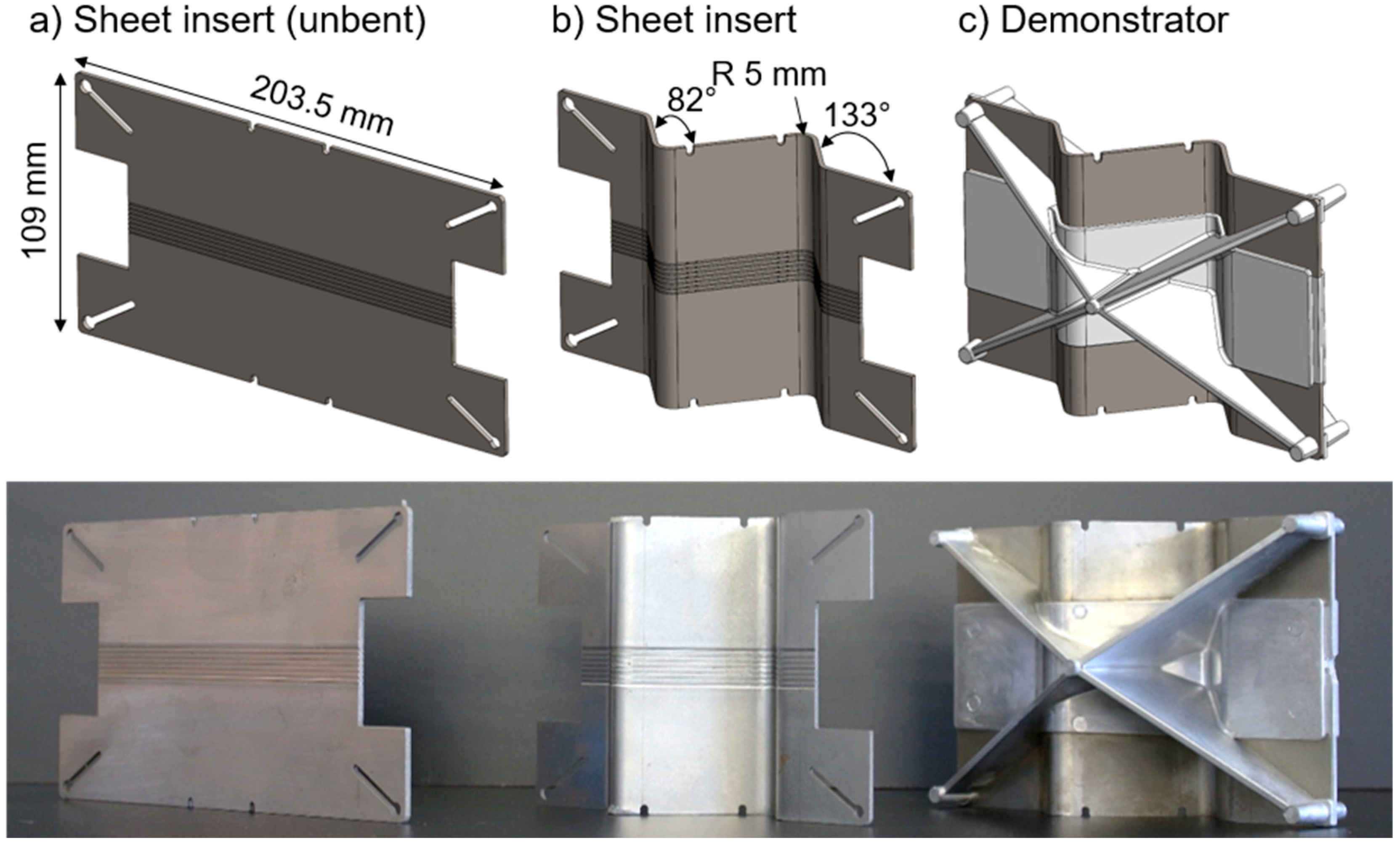
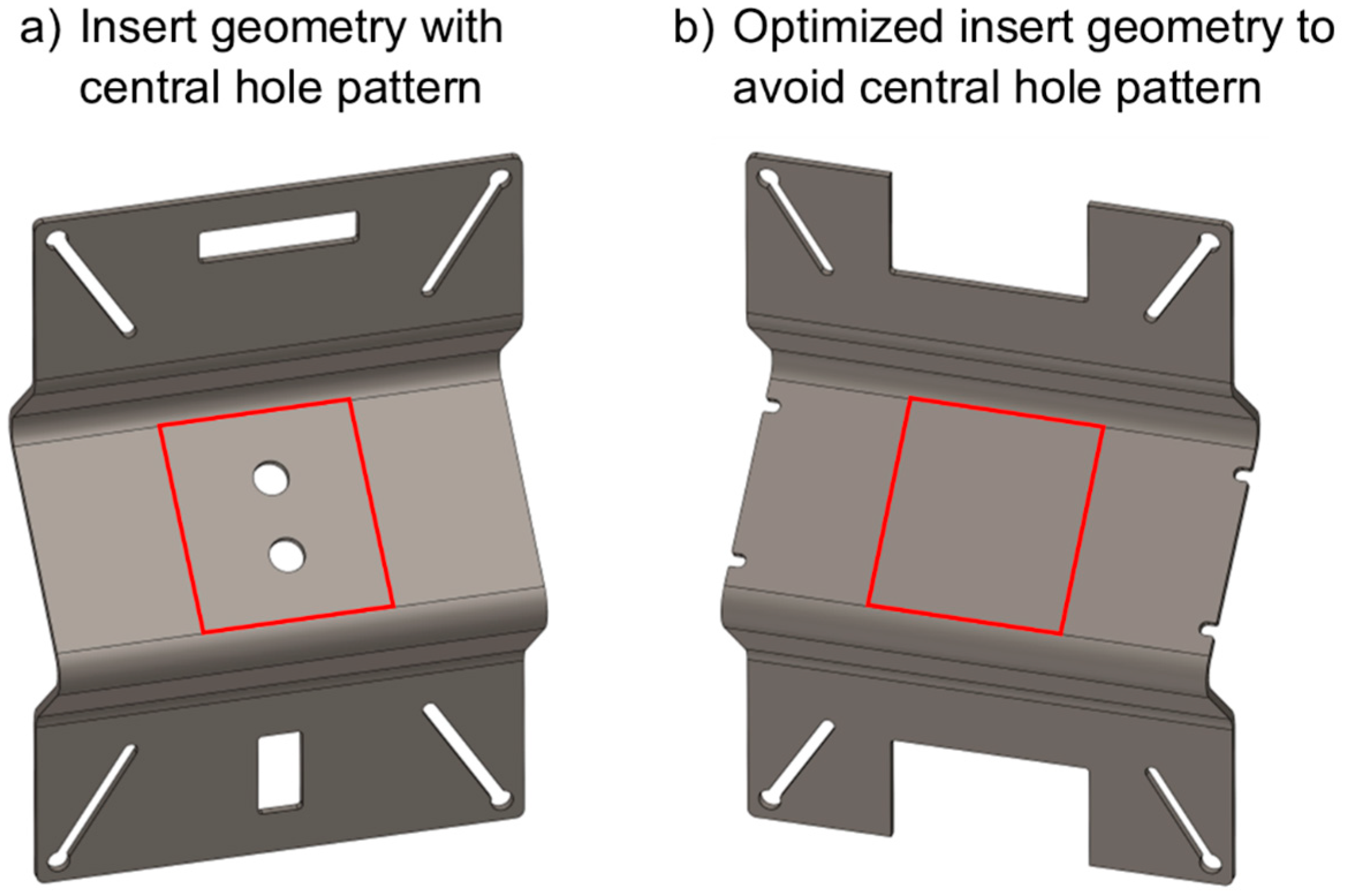



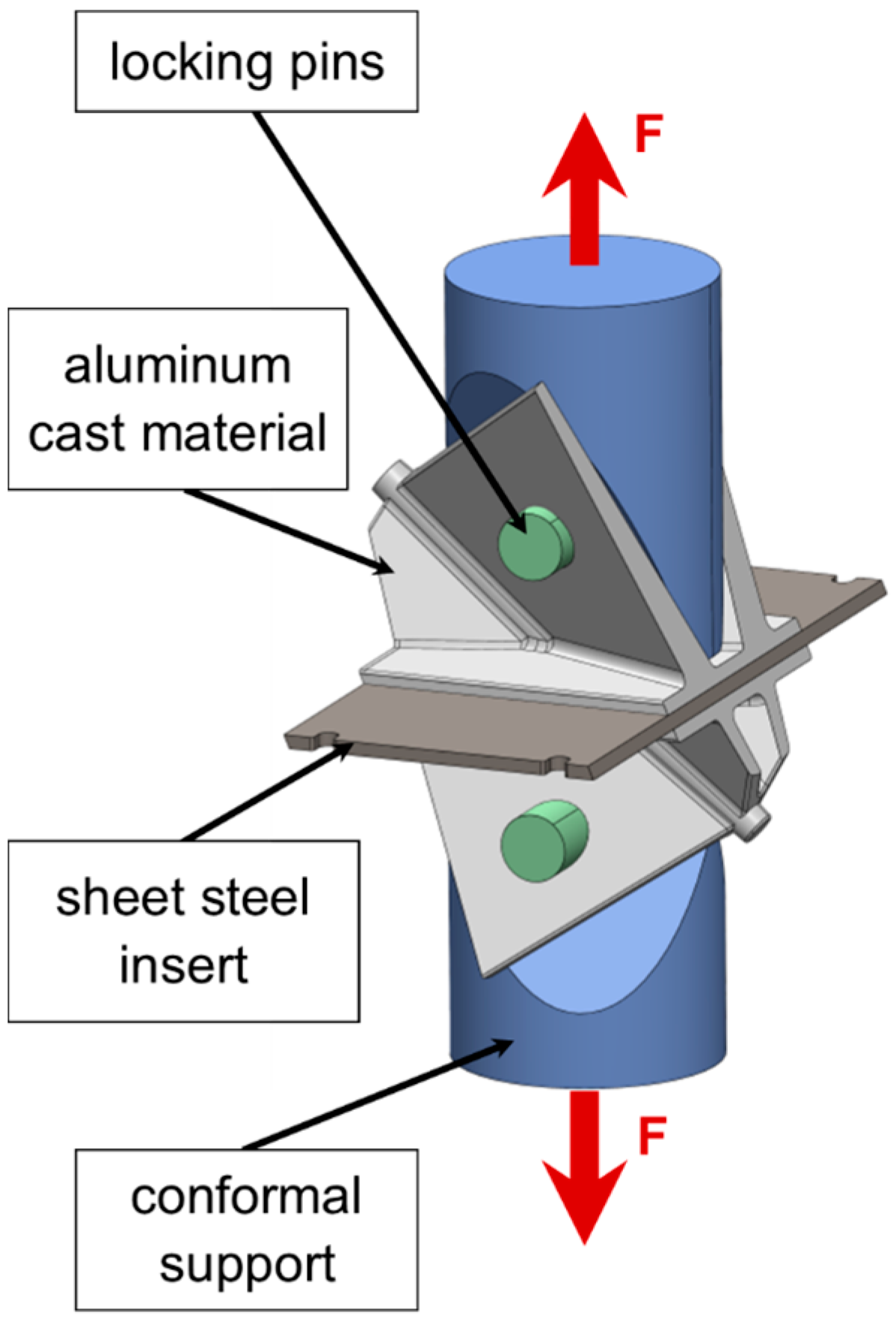



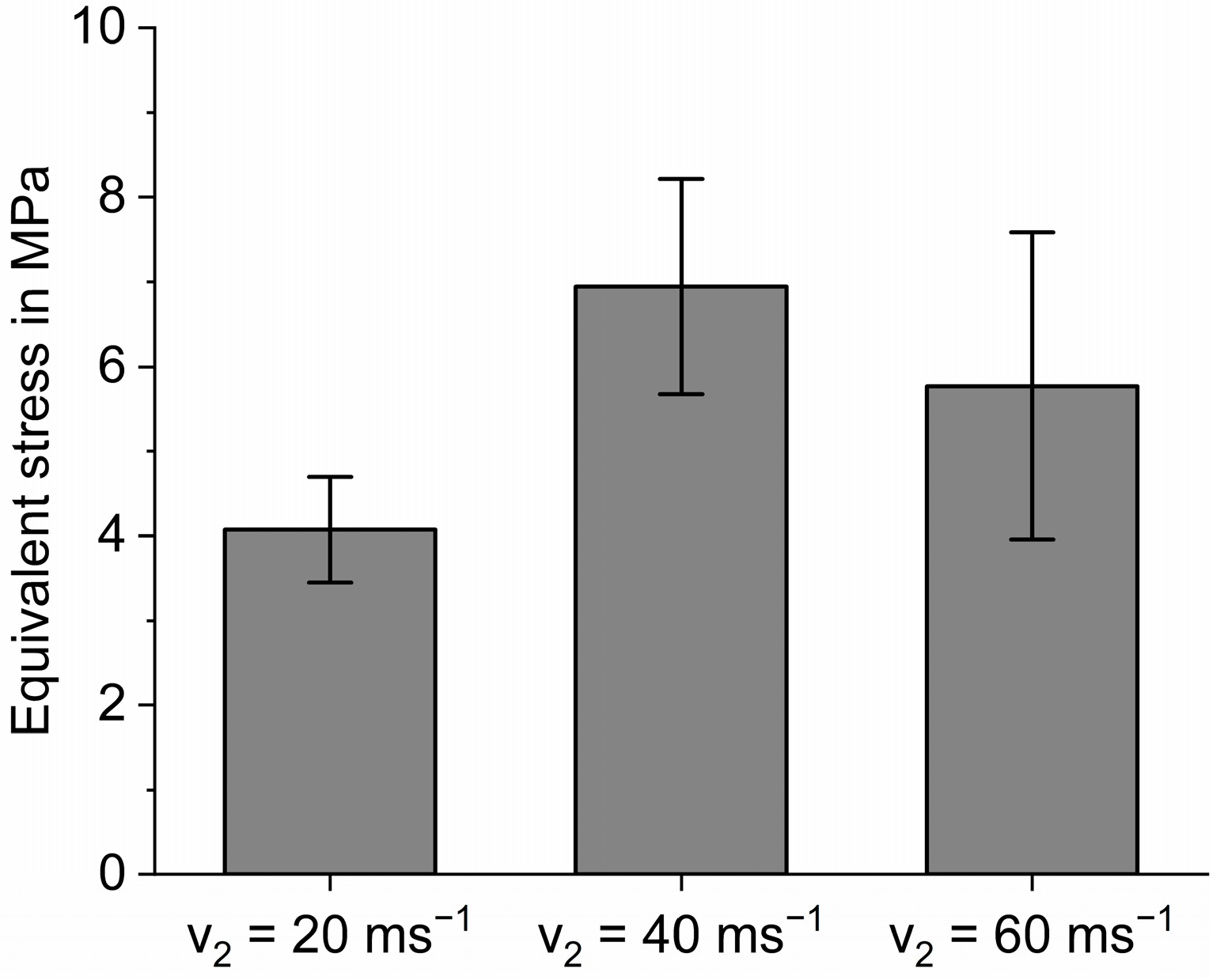


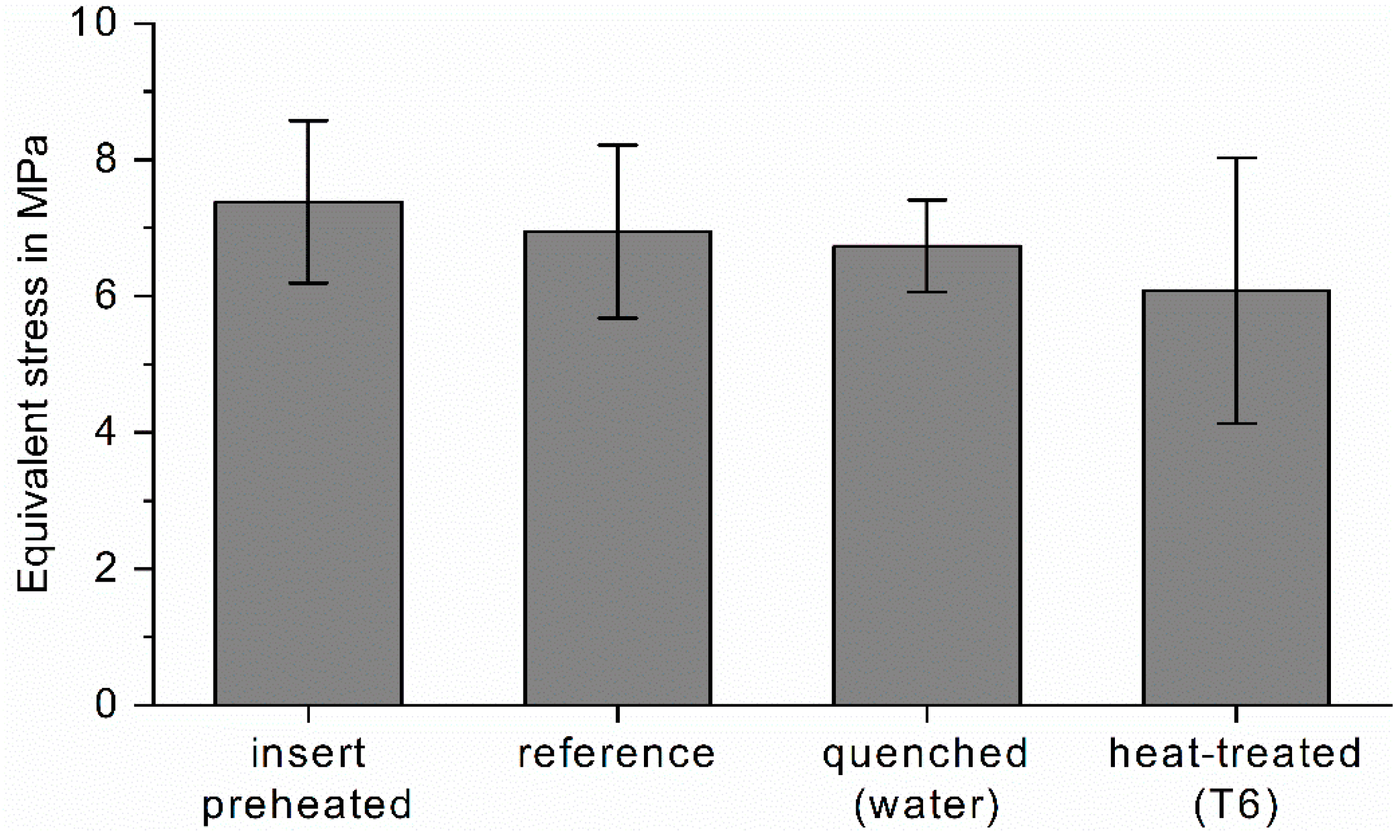
| Element | Si | Fe | Cu | Mn | Mg | Zn | Ti | Sr |
|---|---|---|---|---|---|---|---|---|
| [wt. %] | 11.3 | 0.15 | <0.02 | 0.61 | 0.39 | <0.01 | 0.15 | 0.016 |
| Parameter | Initial Condition |
|---|---|
| Alloy | AlSi10MnMg |
| Shot weight | 1185 g |
| Melting temperature | 760 °C |
| Temperature holding furnace | 720 °C |
| Initial temperature shot sleeve | 220 °C |
| Initial temperature die | 200 °C |
| Average cycle time | 110 s |
| Intensification pressure | 450 Bar |
| Plunger diameter | 60 mm |
| Active shot sleeve length | 417 mm |
| Shot sleeve filling level | 40% |
| ID | Melt Temperature | Die Temperature | Melt Velocity at Gate | Changeover Point | Upstream/Downstream Processes |
|---|---|---|---|---|---|
| 1 * | 720 °C | 200 °C | 40 ms−1 | 265 mm | Air quenching |
| 2 | 760 °C | 250 °C | 40 ms−1 | 265 mm | Air quenching |
| 3 | 720 °C | 200 °C | 20 ms−1 | 265 mm | Air quenching |
| 4 | 720 °C | 200 °C | 60 ms−1 | 265 mm | Air quenching |
| 5 | 720 °C | 200 °C | 40 ms−1 | 240 mm | Air quenching |
| 6 | 720 °C | 200 °C | 40 ms−1 | 280 mm | Air quenching |
| 7 | 720 °C | 200 °C | 40 ms−1 | 265 mm | Pre-heating insert |
| 8 | 720 °C | 200 °C | 40 ms−1 | 265 mm | Water quenching |
| 9 | 720 °C | 200 °C | 40 ms−1 | 265 mm | T6 heat treatment |
| ID | Process Parameter | Equivalent Stress | Reference Comparison |
|---|---|---|---|
| 1 | Reference—13 mm structure | 6.9 MPa | - |
| Reference—25 mm structure | 5.1 MPa | - | |
| 2 | Raised melt/die temperature | 6.7 MPa | +30% (2) |
| 3 | Melt velocity at gate 20 ms−1 | 4.1 MPa | −41% (1) |
| 4 | Melt velocity at gate 60 ms−1 | 5.8 MPa | −17% (1) |
| 5 | Changeover point at 240 mm “Chamber Full” | 4.9 MPa | −30% (1) |
| 6 | Changeover point at 280 mm “Metal at Gate” | 6.5 MPa | −6% (1) |
| 7 | Pre-heating insert | 7.4 MPa | +6% (1) |
| 8 | Water quenching | 6.7 MPa | −3% (1) |
| 9 | T6 heat treatment | 6.1 MPa | −13% (1) |
Disclaimer/Publisher’s Note: The statements, opinions and data contained in all publications are solely those of the individual author(s) and contributor(s) and not of MDPI and/or the editor(s). MDPI and/or the editor(s) disclaim responsibility for any injury to people or property resulting from any ideas, methods, instructions or products referred to in the content. |
© 2023 by the authors. Licensee MDPI, Basel, Switzerland. This article is an open access article distributed under the terms and conditions of the Creative Commons Attribution (CC BY) license (https://creativecommons.org/licenses/by/4.0/).
Share and Cite
Bruckmeier, L.; Ringel, A.; Vroomen, U.; Bailly, D.; Bührig-Polaczek, A. Influence of High-Pressure Die Casting Process Parameters on the Compound Strength of Hybrid Components with Undercut Sheet Metal. Metals 2023, 13, 1717. https://doi.org/10.3390/met13101717
Bruckmeier L, Ringel A, Vroomen U, Bailly D, Bührig-Polaczek A. Influence of High-Pressure Die Casting Process Parameters on the Compound Strength of Hybrid Components with Undercut Sheet Metal. Metals. 2023; 13(10):1717. https://doi.org/10.3390/met13101717
Chicago/Turabian StyleBruckmeier, Lukas, Aron Ringel, Uwe Vroomen, David Bailly, and Andreas Bührig-Polaczek. 2023. "Influence of High-Pressure Die Casting Process Parameters on the Compound Strength of Hybrid Components with Undercut Sheet Metal" Metals 13, no. 10: 1717. https://doi.org/10.3390/met13101717






